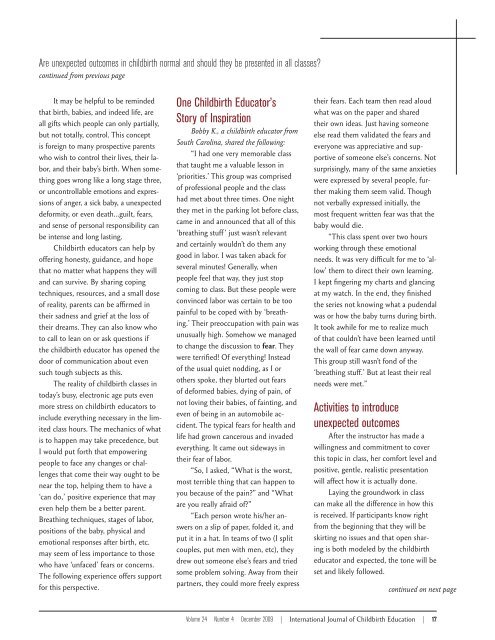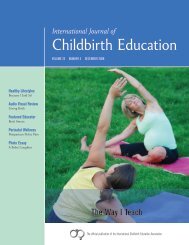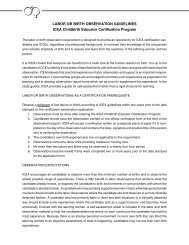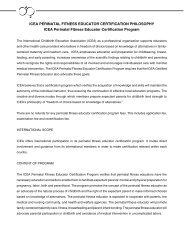Birth Day - International Childbirth Education Association
Birth Day - International Childbirth Education Association
Birth Day - International Childbirth Education Association
You also want an ePaper? Increase the reach of your titles
YUMPU automatically turns print PDFs into web optimized ePapers that Google loves.
Are unexpected outcomes in childbirth normal and should they be presented in all classes?<br />
continued from previous page<br />
It may be helpful to be reminded<br />
that birth, babies, and indeed life, are<br />
all gifts which people can only partially,<br />
but not totally, control. This concept<br />
is foreign to many prospective parents<br />
who wish to control their lives, their labor,<br />
and their baby’s birth. When something<br />
goes wrong like a long stage three,<br />
or uncontrollable emotions and expressions<br />
of anger, a sick baby, a unexpected<br />
deformity, or even death...guilt, fears,<br />
and sense of personal responsibility can<br />
be intense and long lasting.<br />
<strong>Childbirth</strong> educators can help by<br />
offering honesty, guidance, and hope<br />
that no matter what happens they will<br />
and can survive. By sharing coping<br />
techniques, resources, and a small dose<br />
of reality, parents can be affirmed in<br />
their sadness and grief at the loss of<br />
their dreams. They can also know who<br />
to call to lean on or ask questions if<br />
the childbirth educator has opened the<br />
door of communication about even<br />
such tough subjects as this.<br />
The reality of childbirth classes in<br />
today’s busy, electronic age puts even<br />
more stress on childbirth educators to<br />
include everything necessary in the limited<br />
class hours. The mechanics of what<br />
is to happen may take precedence, but<br />
I would put forth that empowering<br />
people to face any changes or challenges<br />
that come their way ought to be<br />
near the top, helping them to have a<br />
‘can do,’ positive experience that may<br />
even help them be a better parent.<br />
Breathing techniques, stages of labor,<br />
positions of the baby, physical and<br />
emotional responses after birth, etc.<br />
may seem of less importance to those<br />
who have ‘unfaced’ fears or concerns.<br />
The following experience offers support<br />
for this perspective.<br />
One <strong>Childbirth</strong> Educator’s<br />
Story of Inspiration<br />
Bobby K., a childbirth educator from<br />
South Carolina, shared the following:<br />
“I had one very memorable class<br />
that taught me a valuable lesson in<br />
‘priorities.’ This group was comprised<br />
of professional people and the class<br />
had met about three times. One night<br />
they met in the parking lot before class,<br />
came in and announced that all of this<br />
‘breathing stuff’ just wasn’t relevant<br />
and certainly wouldn’t do them any<br />
good in labor. I was taken aback for<br />
several minutes! Generally, when<br />
people feel that way, they just stop<br />
coming to class. But these people were<br />
convinced labor was certain to be too<br />
painful to be coped with by ‘breathing.’<br />
Their preoccupation with pain was<br />
unusually high. Somehow we managed<br />
to change the discussion to fear. They<br />
were terrified! Of everything! Instead<br />
of the usual quiet nodding, as I or<br />
others spoke, they blurted out fears<br />
of deformed babies, dying of pain, of<br />
not loving their babies, of fainting, and<br />
even of being in an automobile accident.<br />
The typical fears for health and<br />
life had grown cancerous and invaded<br />
everything. It came out sideways in<br />
their fear of labor.<br />
“So, I asked, “What is the worst,<br />
most terrible thing that can happen to<br />
you because of the pain?” and “What<br />
are you really afraid of?”<br />
“Each person wrote his/her answers<br />
on a slip of paper, folded it, and<br />
put it in a hat. In teams of two (I split<br />
couples, put men with men, etc), they<br />
drew out someone else’s fears and tried<br />
some problem solving. Away from their<br />
partners, they could more freely express<br />
their fears. Each team then read aloud<br />
what was on the paper and shared<br />
their own ideas. Just having someone<br />
else read them validated the fears and<br />
everyone was appreciative and supportive<br />
of someone else’s concerns. Not<br />
surprisingly, many of the same anxieties<br />
were expressed by several people, further<br />
making them seem valid. Though<br />
not verbally expressed initially, the<br />
most frequent written fear was that the<br />
baby would die.<br />
“This class spent over two hours<br />
working through these emotional<br />
needs. It was very difficult for me to ‘allow’<br />
them to direct their own learning.<br />
I kept fingering my charts and glancing<br />
at my watch. In the end, they finished<br />
the series not knowing what a pudendal<br />
was or how the baby turns during birth.<br />
It took awhile for me to realize much<br />
of that couldn’t have been learned until<br />
the wall of fear came down anyway.<br />
This group still wasn’t fond of the<br />
‘breathing stuff.’ But at least their real<br />
needs were met.”<br />
Activities to introduce<br />
unexpected outcomes<br />
After the instructor has made a<br />
willingness and commitment to cover<br />
this topic in class, her comfort level and<br />
positive, gentle, realistic presentation<br />
will affect how it is actually done.<br />
Laying the groundwork in class<br />
can make all the difference in how this<br />
is received. If participants know right<br />
from the beginning that they will be<br />
skirting no issues and that open sharing<br />
is both modeled by the childbirth<br />
educator and expected, the tone will be<br />
set and likely followed.<br />
continued on next page<br />
Volume 24 Number 4 December 2009 | <strong>International</strong> Journal of <strong>Childbirth</strong> <strong>Education</strong> | 17










